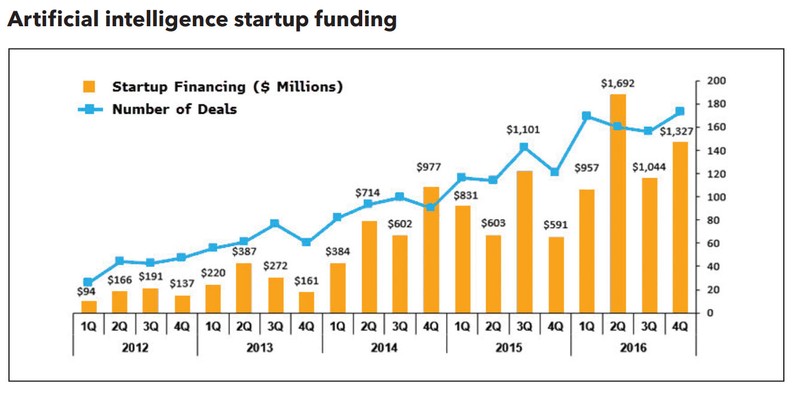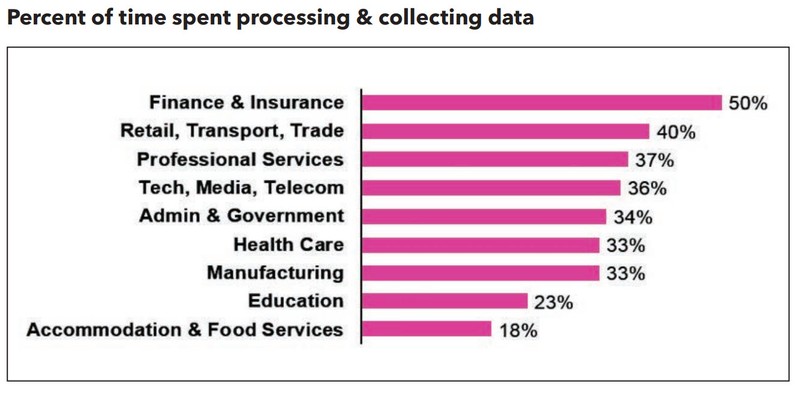A new era: Artificial intelligence is now the biggest tech disrupter
This analysis is by Bloomberg Intelligence analysts Anurag Rana, Anand Srinivasan, Jitendra Waral, Mandeep Singh, Sean Handrahan and Caitlin Noselli. It appeared first on the Bloomberg Terminal.
Artificial intelligence software is likely to be the most disruptive force in technology in the coming decade and companies that embrace AI may get a competitive edge while those that don’t risk extinction.
AI is nascent, but the pace of innovation and disruptive potential of startups will accelerate as computing costs shrink and machine-learning algorithms advance. The ability to self-learn by processing data may spur demand among consumers and enterprises alike.
Cloud computing and machine-learning algorithms have fueled the jump in AI, keeping costs in check while helping applications interpret an ever-growing mountain of data. The tools can process an enormous volume of data, run self-learning algorithms and suggest ways that companies can better understand their customers and boost return on investment.
And as interest has accelerated, investments have followed.
In the coming years, all software applications could feature embedded artificial intelligence. Early examples include Google Photos, messaging chatbots, Google Assistant, Amazon Alexa and IBM Watson. Regular apps will struggle to survive due to the productivity differential of AI-integrated software.
Greater adoption of AI will also add another layer of disruption to the disruptors, as the business models of companies such as Uber, Airbnb and Netflix adapt.
The first disruptive spasms were driven by greater use of smartphones and the cloud; the next will be caused by AI, with cloud-based companies at the forefront. Agility provided by the cloud allows these companies to change products and services much more quickly than legacy rivals.

The way Amazon.com, Google and Facebook use artificial intelligence shows the technology’s potential competitive edge.
Most advancements are behind the scenes, making it difficult to gauge the pace of innovation. Early AI advances may heighten the urgency with which companies adopt the technology, as fears of being outflanked are sparked. AI-driven recommendations are stoking user engagement on YouTube, while computer-vision tools have helped boost Google Photos to a user base of 500 million.
The AI market will grow more than twice as quickly as other high-growth tech areas: It’s only about a third the size of big-data, one quarter as big as security and a tenth the size of the cloud market.
The use of embedded AI continues to expand across industries, from personalized recommendations for online shopping to automated customer service agents that optimize the user’s experience. Banks and retailers are early adopters, while health-care companies and manufacturers are investing more in AI amid advancements in machine and deep-learning. Transportation and utilities are expected to be among the fastest-growing industries for AI products, expanding by 60% compounded annually through 2020.
Total funding for startups using machine learning may be in excess of $12 billion since 2012, while M&A spending is likely to be at least $2.9 billion, according to BI analysis and CB Insights data. Since 2011, Google, Apple and IBM have acquired more AI companies than peers to bolster market share via early advantages. Google bought at least 12 companies with AI specialization. Apple and IBM acquired at least seven apiece. Intel and Microsoft have each made five or more deals since 2011.
Growth in cloud computing, new methodologies and improved databases are making it possible to analyze this data in real time.
The volume of data created each year is rising about 36%, according to IDC. Unstructured — or “dark” — data is the biggest component of this growth, sparking new challenges and opportunities for companies to better understand their customers. Increased use of social media and smartphones creates the trove of data, including videos, pictures and texts.
Falling data-storage prices are also a major factor enabling unstructured data analysis. DRAM memory prices declined 38% in 2011-15 and are expected to fall another 25% in 2017-2021, based on IDC.
Deep-learning technology, which enables computers to approach human-level skills at intuitive tasks such as computer vision, was a breakthrough in making artificial intelligence applications commercially viable. It requires running massive data sets through a network of functions that can improve at making probability-based decisions on tasks such as recognizing images, optimizing costs or translation.
The rise of AI technology is likely to create jobs at first, as early solutions aid productivity and require coding and technology workers. Longer term, however, expanding functionality may hurt data processing and collection workers, based on a McKinsey study.
Workers in these segments making $200,000 or more may be among the first affected. They spend 31% of their time on data-intensive tasks and there’s less return on investment of their work.
Within the $393 billion software industry, the $48 billion business analytics software segment will likely be the most disrupted by artificial intelligence. Companies in this segment focus on collection, processing, analyzing and visualization of data.
Oracle, Microsoft, SAP and IBM are the leading companies in the business analytics software segment, according to IDC. The segment is expected to grow
8% a year in 2015-20 to reach $61 billion.

Digital advertising and e-commerce are likely to be among the earliest sectors to get a sales boost from their adoption of artificial intelligence technologies. Machine learning is likely to improve targeting efforts for programmatic digital ads and purchase recommendations in e-commerce.
Facebook, Apple and Google are likely to be major players in deriving revenue from chatbots and virtual assistants by integrating services. The Android/ iOS mobile phone duopoly supports each company’s general purpose voice assistant, as IDC projects 72.4% of devices with embedded virtual assistants will be mobile phones in 2020.
Data-intensive industries such as financial services and those using the internet may be among the first disrupted by artificial intelligence. Half of the time spent by workers in finance and insurance is allocated to processing and collecting data, based on a McKinsey study, the highest among various industries.
Within IT services, the voice-business process outsourcing segment will likely be among the first areas to be affected by AI. This segment includes call-center work, an area that can be disrupted by self-learning bots.
The health-care sector is the biggest private funder of artificial intelligence startups, with the industry devoting far more to AI versus its lagging IT spending.
Just 4% of global technology spending comes from health care.